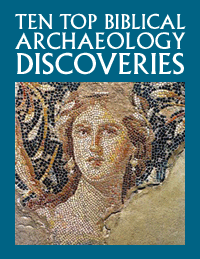
Archaeologist Aren Maeir, who has directed excavations at Tell es-Safi/Gath for more than 25 years. Photo courtesy of Aren Maeir.
One of Hershel Shanks’s (z”l) contributions to archaeology, and that as a non-archaeologist, was to stand up more than 25 years ago and bravely call out the “Emperor’s New Clothes” of biblical archaeology—the glaring lack of final reports of many of the excavations conducted in the Near East, particularly in Israel.*
Since then, no doubt partially thanks to Hershel’s cry, the publication of excavations has drastically improved. Many older excavations have been published (e.g., Hazor, Jewish Quarter, Masada, Temple Mount, Ashdod, and City of David). For the most part, a new standard has been set for the publication of recent excavations, with a regular flow of articles reporting ongoing research—and an impressive amount of final reports (e.g., from Beth Shean, Ashkelon, Megiddo, Rehov, Tell es-Safi/Gath, Khirbet Qeiyafa, Ramat Rachel, and Kabri).
There is no doubt that the harsher demands of tenure committees at universities, which require impressive CVs and lists of publications, along with the clear stance of the Israel Antiquities Authority, which requires reports before issuing licenses, have helped improve the “publication problem.” I also believe that the current generation of project leaders have taken on a stronger professional—and ethical—commitment to publish their work within their lifetime. I was very fortunate to have Amihai (Ami) Mazar as my doktorvater. Ami set a shining example for how to publish excavations. There are few archaeologists in Israel with as impressive a list of final excavation reports as his.

That said, the “publication problem” has not completely gone away. There are still excavations from many years ago that have not been fully published, such as Kathleen Kenyon’s excavations in Jerusalem which are still in the process of publication, some 50 years after the end of fieldwork. More so, one still sees archaeologists who don’t believe that it is important to put out regular interim reports, and who also continue excavating, site after site, before finishing the final reports of previously excavated sites. Besides the professional commitment to publishing your work, leaving unpublished excavations forces future generations to spend time and (limited) resources on publishing finds that were excavated years ago, using methods and asking questions not at the cusp of current research.1
Putting it bluntly, we must clean up our own garbage! To be a responsible archaeologist, you must excavate while considering the time and resources required to publish the finds. You can’t just assume that you’ll excavate and excavate—and one day, when you have time, research and publish the finds. The time is now—as you excavate. You should not continue excavating if you have not caught up with your publications.

Cover of the second volume of the Tell es-Safi/Gath final excavation report, which was published in 2020. Photo courtesy of Aren Maeir.
With this in mind, I recently decided that after 25 years of excavation at Tell es-Safi/Gath, one of the largest and most interdisciplinary projects conducted in Israel (and perhaps the world), the time had come to stop large-scale summer excavations. After a quarter-century of research and many publications, the responsible thing to do was to scale down the project and concentrate on the final publications.
Surprisingly, while some of my colleagues viewed this positively, quite a few were somewhat taken aback. They wondered why in the world I would do such a thing! As we all know, excavating is hard—but a lot of fun—and who wants to stop having fun?
But I believe this is what must be done. While I have directed an excellent field project for many years, coordinated fascinating inter- and multi-disciplinary research, published extensively, and received large grants and occasional donations that enabled this all, one can’t go on indefinitely. I will retire from Bar-Ilan University in about four years, and I would like to finish publishing all the excavation results within the next decade.
So, in summary, I believe publishing your excavations in your lifetime is perhaps the most important part of an archaeologist’s professional role. I am trying to keep to this standard, and I hope I will serve as an example for my colleagues, students, and future generations.
We must publish—or the finds will perish!
Notes:
* Hershel Shanks, ed., Archaeology’s Publication Problem (Washington, DC: Biblical Archaeology Society, 1996).
1. Aren M. Maeir, “A Response to ‘On Delays in the Publication of Excavation Reports’ by P.J. Parr (PEQ 152.3, 181–83),” Palestine Exploration Quarterly 153.1 (2021), pp. 1–4.
About the Author
 Aren M. Maeir is Professor of Archaeology at Bar-Ilan University in Israel. He directs the Tell es-Safi/Gath Archaeological Project, which is processing and publishing its discoveries.
Aren M. Maeir is Professor of Archaeology at Bar-Ilan University in Israel. He directs the Tell es-Safi/Gath Archaeological Project, which is processing and publishing its discoveries.
Read more in Bible History Daily:
The post Publish or Perish appeared first on Biblical Archaeology Society.


0 Commentaires